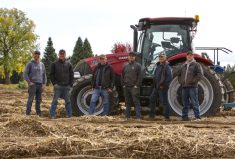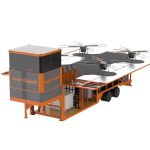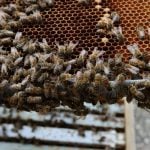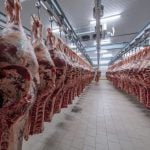In Canada’s northern regions, where the growing season is so short it can seem non-existent in any agricultural sort of way, fresh food from California and Mexico is not only expensive due to the transportation costs; all too often, it is no longer fresh.
After experiencing first-hand how the high cost of fresh, healthy food was hurting Canadians in the North, Corey Ellis and business partner Alida Burke dedicated themselves to making local, fresh produce accessible to all, no matter the climate.
In 2016, Ellis and Burke began retrofitting shipping containers so they could be used as vertical farms, which led to the birth of their Ottawa-based social enterprise Growcer. It seemed the right fit for the pair who had been looking into social enterprise, i.e. the concept of using business tools to solve a social or environmental problem.
Read Also

Ground rules for farm family communications
Establishing meeting ground rules can help your family find ways to communicate that work for your farm. Here are some…
Two years ago, they switched from up-cycling shipping containers into vertical farms to making pre-fab buildings which are more durable, spacious, ergonomically friendly and efficient, and also much better insulated.
Can their idea make a difference? In total, about 55 Growcer vertical farms are now in use across Canada.
One of those growing units is owned and operated by the co-op grocery store in Yellowknife, so it now has a secure year-round supply of fresh leafy greens including kale, spinach, bok choy, herbs and lettuces.
Also important is that while the cost of lettuce may spike elsewhere due to a drought in California, the cost of producing lettuce at the Yellowknife store remains constant, making for a more resilient supply chain, says Ellis.
This hyper-local strategy could help ease food insecurity in Canada’s North, says Thomas Graham, director of the Controlled Environment Systems Research Facility (CESRF) at the University of Guelph.
It’s all part of a new science called controlled environment agriculture (CEA), and while most vertical farming facilities to date are focused on microgreens, baby greens and leafy greens, Graham says there is no limit to what could be grown with proper research and investment.
Given that nutritious food is essential to wellness, he thinks an argument could also be made for justifying the cost of vertically farmed fresh fruits and vegetables in Canada’s North on the grounds of health care cost reductions.

The basic components of a vertical farming facility in the North include a well-insulated building, a good HVAC system to ensure the air flow and humidity control needed to prevent disease, a growth system (e.g. hydroponics in which water and nutrients are delivered during irrigation) and efficient LED lighting.
Graham sees numerous advantages with vertical farming. A lot of produce can be grown in a small space because with electric lighting, growth trays can be stacked several layers high. The controlled environment also makes it possible to collect and re-use the water needed during production and to capture any leftover nutrients, although Graham notes there is still room for improvement.
The controlled environment also creates opportunities to change the output by changing the inputs. For example, the colour of the light can be manipulated when growing lettuce to change the nutritional content and flavours of the crop. When appropriate varieties of leaf lettuce are grown under lights with more blue than regular daylight, for instance, the leaves turn red. The compounds making the leaves red are anti-oxidants that can have nutritional benefits when we eat them.
It’s creating the potential for a lot of research, Graham says. “Given the incredible flexibility we have in manipulating the colour of light with modern LED lighting systems, it will take a lot of work to develop just the right spectrum for each variety at each stage of development.”
In the next five to 10 years, Graham thinks we’ll see many other improvements in addition to optimizing their management of light. Some of these changes would involve an increase in the type of crops that are grown including those with a higher caloric content than leafy greens, as well as more culturally relevant foods and traditional Indigenous foods.
Plant breeding to select and/or develop varieties that perform well in CEA is another area of research. Work is also underway to manipulate the plants to produce medicines and vaccines.
Researchers are working towards a closed-loop system and Graham predicts the growing systems will also get more efficient as artificial intelligence, robotics, machine learning and feedback from the data sensors are utilized more effectively. More work on the economics is also needed, he says.
Controlled environment agriculture isn’t a replacement for conventional agriculture, but the systems have a lot of potential, and with the right backing, Graham says, they can help with food insecurity in both extremely cold and hot climates. “This technology isn’t going to fix everything when it comes to food insecurity, but it is certainly an important part of the solution.”
Evan Fraser, director of the University of Guelph’s Arrell Food Institute, agrees CEA has “tremendous potential” but he cautions that there are still questions about its sustainability. “It still takes a fair bit of energy” to grow a crop, and unless that energy is supplied by a renewable source, it’s not ideal, he says.
And while CEA does hold great promise to create “more robust, resilient, profitable, lower-carbon vegetables for Canadians,” in Fraser’s opinion, food insecurity — defined as a lack of reliable access to a sufficient quantity of affordable, nutritious food — will not be solved by technology.
Food insecurity, he points out, isn’t production-related and it isn’t a result of not having enough food. The reason that about 15 per cent of Canadians, the majority of whom are Black, Indigenous and people of colour, are food insecure is because of colonialism, poverty and the high cost of living, says Fraser. “If we don’t tackle these social issues, we’re never going to solve food insecurity.”
Dinner on Mars
If (or is it when?) humans colonize Mars, food will have to be produced on location because it will not be possible to shuttle it from Earth. It won’t be simple. A Martian agri-food system must be closed-loop. Farmers there won’t have the luxury of digging up new resources, and the food industry won’t be able to accumulate waste as has been the case here on Earth.
These assumptions formed the basis of a thought experiment conducted by Evan Fraser, director of the University of Guelph’s Arrell Food Institute and Lenore Newman, the director of the Food and Agriculture Institute at the University of the Fraser Valley, to imagine how a colony on the red planet would feed itself.
Newman and Fraser chronicled this thought experiment in their newly published book, Dinner on Mars: the technologies that will feed the Red Planet and transform agriculture on Earth (ECW Press, 2022).
While the pair have created an imaginative scenario for how humans could one day sustain themselves on Mars, even more interesting are the implications for applying these same technologies on our own planet as we face a climate crisis. They predict technologies including more efficient controlled environment agriculture will be available in the not-too-distant future. With smart government policies and incentives for farmers, these technologies would help us feed a growing population on earth while decreasing agriculture’s reliance on fossil fuels and its greenhouse gas emissions.
Homegrown Innovation Challenge
Launched in 2022 by the Weston Family Foundation, the Homegrown Innovation Challenge aims to find solutions to the challenges that currently prevent out-of-season production of fruits and vegetables at scale. Delivered over six years, the challenge’s website says the goal is to identify teams and to support the development of tools and technologies that will “enable Canadian farmers and producers to sustainably and competitively grow berries out of season.”
















